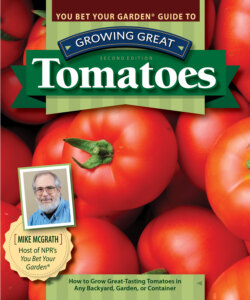Читать книгу You Bet Your Garden Guide to Growing Great Tomatoes, Second Edition - Mike McGrath - Страница 12
На сайте Литреса книга снята с продажи.
More Stuff to Think About
ОглавлениеNow that you’ve determined which type you most want to grow, you’ll probably want to lie down and rest for awhile. Too bad! Tomato growing isn’t for wimps, and you’re not done yet; there are other seed catalog variables you’ll want to consider before making your choices.
DAYS TO MATURITY (DTM)
You should see a specific number of days listed on every packet of seed, included in the description of each tomato variety in seed catalogs, and, if you’re lucky, on those little plant tags stuck in the dirt of garden center transplants. An intelligent person might presume it refers to the average number of days it will take before you bite into your first ripe tomato, which would be correct for a plant you buy already started at the garden center, but a damned lie for the seed packet and/or catalog, because it is actually the number of days it will take the average six-week-old transplant to produce edible fruit. So for plants you start from seed, you would add fifty or sixty days of anxious anticipation to that number. (The extra time is for the seeds to germinate and for the always necessary Wiggle Room.)
….Hmmm. You know, by law, these numbers only have to be found on seed packets, so why should we have to do the math?
[bad img format]
Seed packets (and plant tags) may or may not reveal the determination of a tomato, but most will have a DTM (days to maturity) number on the seed packet and/or plant tag. That’s the number of days on average that will pass after you put a six- to eight-week-old transplant in the ground before you can expect to pick your first ripe tomato—no matter how much you encourage and/or threaten the plant.
Oh well, DTMs are very useful numbers, especially if you live in a frequently frozen latitude. A short growing season means you should stick with tomatoes with the lowest DTMs, even if you intend to start them early, protect them with special warming things like cloches, row covers, or Wall-O-Waters early in the season, and so forth. And yes, the corollary is also true; if you have a long season, do look for big numbers. Take advantage of what some of us don’t have—lots of growing days—and enjoy the rarest and best-tasting heirlooms, some of which can take what seems like forever to produce their first ripe fruit.
Obligatory Cheech and Chong joke:
Q: “Hey man—how good is it?”
A: “It’s here; that makes it great.”
Otherwise, plant as many different kinds of tomatoes as you can fit into your garden space: beefsteaks, slicers, oxhearts, heirlooms, patios, plums, pears, cherries…!
Before we move on, though, let’s get into DTMs in a bit more detail. Really short DTMers like Early Girl and Stupice (named after me) can produce ripe love apples in 50 or so days. They ain’t the best tasting, but they’re there. (Insert Cheech and Chong joke here. Or right there on the side of this page works too.)
On the other end of the scale, some big honking heirlooms can take up to 90 or 100 days. Do the math. Oh, OK, I’ll do it: The math says you better have enough time in the growing season where you live.
DTMs under 70 will almost always be determinate varieties that produce most of their fruits within a tight span of a few days and then maybe a few more over the course of the season, but not enough to justify their garden footprint. Farmers love this. They can circle a date 55 days from planting big, healthy starts, schedule the picking, and then be ready to plant the follow-up crop, like string beans or garlic. Most home gardeners with a single plant in the ground, though, were not hoping for twenty pounds of fruit on Thursday.
Your options if you have an avalanche of tomatoes on the aforementioned Thursday:
Make tomato sauce early. Many—if not most—“early” varieties were bred for processing. If it’s damn hot (as opposed to just hot), do it on that side burner on your outdoor grill.
Keep an eye on your neighbor’s gardens. If they’re growing big honking heirlooms, they’ll be lucky to have flowers, much less greenies, when your crop comes in. Put six of your nicest-looking dead-ripe red love apples in a brown paper lunch bag, wait for your neighbors to pull into their driveway, and walk over with your gift. “We’ve noticed your tomatoes don’t seem to be doing too well, and we have more than we can use…” (Philadelphia note: “It is not enough to succeed; others must fail.”)
Otherwise, you will wait until mid-August (in the Mid-Atlantic and North) for the big heirloom beefsteaks to ripen up. (Actually, they’ll still be green; just wanted you to feel better/worse). Do the math, Kookie—add 90 days to June 1st (it was a cold spring) and whaddya get? At least those brats of yours are back in school.
